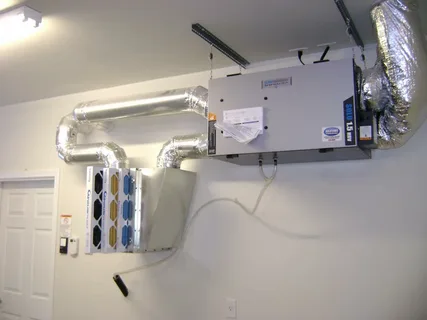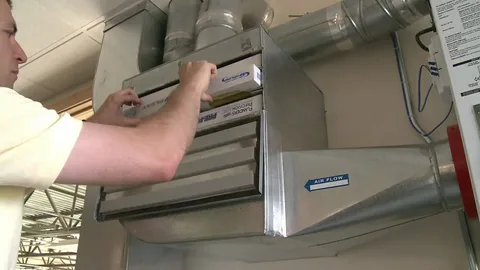In today’s world, where air quality and energy efficiency are more important than ever, HRV Ventilation emerges as a key player in maintaining a healthy and sustainable environment in both residential and commercial spaces. But what exactly makes HRV Ventilation systems so crucial for modern living, and how can they transform your space into a healthier, more efficient place? Let’s dive deep into the world of HRV Ventilation and unlock its full potential for your space.
Understanding HRV Ventilation and Its Core Principles
HRV Ventilation, or Heat Recovery Ventilation, embodies a sophisticated method of maintaining indoor air quality and temperature control while reducing energy consumption. The mechanism behind HRV systems involves a clever exchange process where outgoing stale air passes by incoming fresh air within a heat exchanger. In this encounter, the heat from the exhausted air is captured and transferred to the incoming cold air, pre-warming it before it enters the living space.
This heat exchange method is the cornerstone of HRV technology, ensuring that the indoor climate remains stable and comfortable without over-relying on traditional heating or cooling systems. By leveraging the thermal energy already present in the indoor air, HRV systems exemplify a sustainable approach to temperature control and ventilation, positioning them as an essential component of modern, energy-efficient building designs.
This principle of reusing energy that would otherwise be wasted underscores the system’s efficiency and its contribution to a greener living environment. With proper installation and maintenance, an HRV system can significantly cut down on your energy bills and reduce your carbon footprint. Beyond environmental benefits, the advanced ventilation provided by HRV also contributes to improved indoor air quality, offering a healthier living environment for you and your family.
 Boosting Indoor Air Quality with HRV Ventilation System
Boosting Indoor Air Quality with HRV Ventilation System
An HRV Ventilation System is a powerhouse when it comes to enhancing the air quality inside your space. It operates on a continuous cycle, drawing in fresh air from the outside while expelling the stale, pollutant-laden air from indoors. Unlike traditional ventilation solutions that may inadvertently increase energy consumption, HRV systems maintain efficiency by ensuring that the incoming air is pre-warmed through the heat exchange process.
This not only conserves energy but also ensures that the air circulating within your space is not only fresh but also free of common pollutants and allergens. Furthermore, HRV systems come equipped with filters that purify the incoming air, reducing the presence of harmful particles and contributing to a healthier indoor environment. This filtration process is essential for areas prone to high pollution levels or for individuals with allergies, as it provides a cleaner, more breathable air.
The continuous renewal and purification of indoor air by HRV systems support a healthier living and working environment, making it an indispensable tool in our pursuit of well-being and efficiency in our spaces. In addition, HRV systems offer substantial cost and energy-saving benefits, giving you value for your money while caring for the environment. Harnessing the power of an HRV system truly allows you to breathe easier and live better.
Energy Efficiency: How HRV Ventilation Reduces Costs
One of the standout benefits of HRV Ventilation lies in its remarkable capacity to slash energy expenditures, serving as a pivotal aspect for eco-conscious individuals aiming to trim their utility costs. The inherent design of HRV systems revolves around a heat exchange process that meticulously recycles warmth from expelled indoor air, transferring it to the incoming fresh air. This ingenious mechanism significantly curtails the demand placed on heating systems during cooler months, while similarly easing the load on cooling systems when temperatures rise.
Consequently, the reliance on traditional heating and cooling apparatus is reduced, paving the way for a marked decrease in energy consumption. The strategic reuse of thermal energy inherent in the indoor air not only fosters a sustainable living or working environment but also translates into tangible cost savings on energy bills. This economical operation underscores the HRV system’s role as a cornerstone in the pursuit of not just an energy-efficient but also a financially savvy space, underlining its importance in today’s energy-conscious landscape.
With escalating energy prices and increasing environmental awareness, an HRV system is no longer a luxury but an essential tool for responsible homeowners and businesses. Its sustainable mechanism can set a new standard in the maintenance of indoor air quality, without compromising on economic feasibility.
The Role of Heat Recovery and Ventilation System in Humidity Control
Managing indoor humidity effectively is crucial for maintaining a comfortable and healthy living environment, and this is where Heat Recovery and Ventilation system excels. By systematically exchanging the moist, stale air inside your space with fresh, dry air from outside, HRV Ventilation plays a pivotal role in controlling indoor humidity levels. This capability is especially beneficial in climates prone to high humidity, where excess moisture can become a persistent issue, potentially leading to mold and mildew growth, as well as contributing to discomfort and various health problems.
HRV systems address these challenges head-on, ensuring that indoor air remains at an optimal humidity level. This proactive approach to humidity management not only safeguards the structural integrity of your space and the health of its occupants but also enhances the overall air quality. By maintaining a balance between indoor and outdoor air exchange, HRV Ventilation systems provide a solution that keeps your environment comfortable, irrespective of the weather conditions outside.
Easy Integration and Compatibility with Existing Systems
HRV Ventilation systems stand out for their seamless adaptability with a wide range of pre-existing HVAC setups. This adaptability makes them an appealing addition not only for new construction projects but also for upgrading older buildings to enhance air quality and energy efficiency. Their design allows for a smooth transition and incorporation into your current heating and cooling systems without the necessity for a comprehensive overhaul.
This compatibility ensures that integrating an HRV system into your space can be achieved with minimal disruption to your existing infrastructure. Whether you’re aiming to retrofit an older home or looking to incorporate HRV into a modern commercial building, the process is designed to be as straightforward as possible. This ease of integration highlights the HRV system’s flexibility and its ability to work hand-in-hand with your current setup, enhancing the performance of your HVAC system while simultaneously improving indoor air quality and energy conservation.
In fact, with an HRV system in place, your space becomes not only more energy efficient but also more comfortable and healthier to occupy. This marks an important advancement in indoor climate management strategies.
Enhancing Comfort and Well-Being with Air Recovery Ventilation System
Air recovery ventilation system extends its benefits beyond mere temperature and air quality management, playing a pivotal role in elevating the comfort and wellness of those within the space. By offering a steady influx of fresh air, HRV Ventilation creates an environment that is not only more invigorating and refreshing but also conducive to mental and physical health.
The subtle yet consistent control over indoor climates prevents the stuffiness and lethargy often associated with poor ventilation, promoting a sense of well-being and increased productivity among occupants. The reduction in pollutants and allergens further enhances this effect, contributing to a cleaner, more healthful environment that supports those with respiratory concerns or sensitivities. By aligning closely with human comfort levels and health standards, HRV systems underscore their role as not just a technological innovation, but as a facilitator of a more comfortable, health-oriented living and working spaces.
HRV Ventilation: A Sustainable Choice for the Future
As we navigate through an era where environmental responsibility takes center stage, HRV Ventilation stands out as an emblem of sustainability. This innovative system aligns with the global push towards minimizing carbon footprints and promoting energy conservation. By harnessing the warmth of expelled indoor air to pre-heat or pre-cool the incoming fresh air, HRV systems showcase a remarkable ability to enhance energy efficiency within our homes and workplaces.
This process not only curtails the dependency on fossil fuel-driven heating and cooling systems but also supports a reduction in greenhouse gas emissions. Consequently, the adoption of HRV technology contributes positively to the fight against climate change, reflecting a commitment to preserving our planet for future generations.
As individuals and communities become increasingly aware of the impact of their actions on the environment, HRV Ventilation emerges as a practical, effective solution for fostering a healthier, more sustainable world. Its integration into our living and working spaces serves as a testament to our collective efforts towards achieving a balance between comfort, efficiency, and environmental stewardship.
Optimizing Performance When you Buy Heat Recovery Ventilator
To unlock the full potential when you buy heat recovery Ventilation, selecting the right size and model for your specific needs is paramount. An undersized unit won’t efficiently manage the air quality and temperature of your space, while an oversized unit can lead to unnecessary energy consumption and wear. Consulting with HVAC professionals to determine the most suitable HRV system for your area is a critical first step. Following the installation, consistent maintenance becomes key to sustaining optimal performance.
This involves routine checks and cleaning of filters, vents, and heat exchangers to prevent blockages that can impair efficiency. Ensuring that the system settings are correctly adjusted according to seasonal changes will also enhance its functionality, allowing for the best possible comfort and energy savings. Taking these steps not only extends the lifespan of your HRV system but also guarantees that you’re making the most out of your investment by achieving the ideal balance of air quality, energy efficiency, and cost savings.
FAQs
– **What makes HRV Ventilation an essential addition to modern living spaces?**
HRV Ventilation systems play a crucial role in modern living spaces by efficiently managing air quality and temperature. They utilize a heat exchange process to pre-warm incoming fresh air with thermal energy from outgoing stale air, enhancing comfort without sacrificing energy efficiency. This makes them an invaluable tool in creating healthier, more sustainable living environments.
– **How do HRV systems contribute to energy savings?**
By leveraging the heat from expelled indoor air to warm up the incoming fresh air, HRV systems significantly reduce the reliance on conventional heating and cooling systems. This efficient reuse of energy not only minimizes overall energy consumption but also contributes to noticeable savings on utility bills, making HRV systems a smart choice for eco-conscious homeowners.
– **Is integrating an HRV system into my existing HVAC setup a complex process?**
Integration of an HRV system into an existing HVAC setup is typically straightforward, thanks to their design which allows for compatibility with a wide range of heating and cooling systems. Professional HVAC technicians can ensure seamless integration, enhancing your space’s air quality and energy efficiency with minimal disruption to your current system.
Conclusion
Embracing HRV Ventilation in our homes and workplaces represents a forward-thinking approach to healthier living and environmental stewardship. These systems offer a dual advantage: they significantly improve indoor air quality while simultaneously reducing energy consumption, aligning with both personal wellness goals and global sustainability efforts. As we’ve explored, the benefits of HRV Ventilation extend beyond simple temperature control, touching on aspects crucial for our well-being, such as humidity management, air purity, and comfort. Moreover, their compatibility with existing HVAC systems and the potential for noticeable energy savings underscore HRV’s role as a smart investment in our future. By prioritizing the integration of HRV technology, we take a significant step towards creating spaces that not only support our health but also contribute to the well-being of our planet.
| Other Good Articles to Read |
| blogs rain |
| cme blogspot |
| Garcias Blogs |
| Yyc Blogs |
| Guiade Blogs |
| Blogs-Hunt |
| Impact-Blog |
| Smarty Blogs |
| Ed Blog |
| Mo Blogs |
| Blogs Em |
| blogs t |
| Related Business Listings |
| Contact Directory |
| Local Business Profiles |



